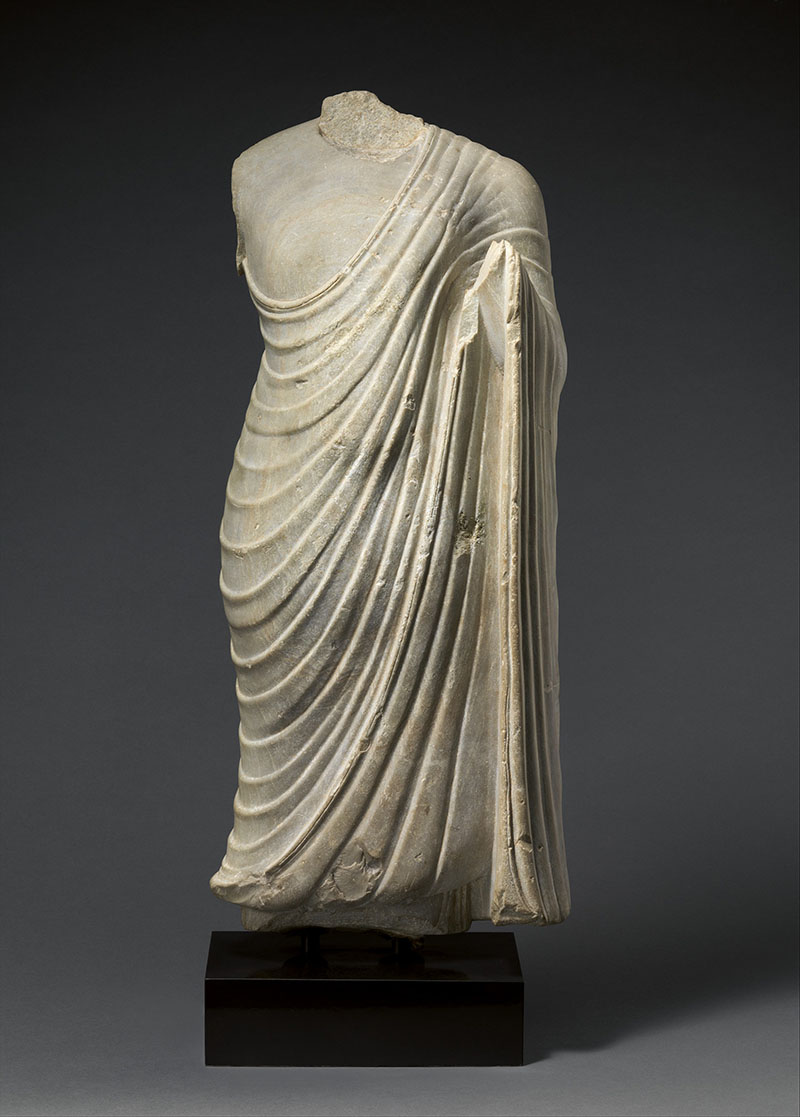A group of Buddhist sculptures dating to the third and fourth centuries CE, the standing Buddhas at Nagarjunakonda were recovered from archaeological excavations at Nagarjunakonda in the Guntur district of modern-day Andhra Pradesh. Nagarjunakonda (translating to “Nagarjuna’s Hill” in Telugu) was the site of the ancient city of Vijayapuri, the capital of the Ikshvaku Dynasty in the third and fourth centuries CE. It was an important centre for various sects of Buddhism, as well as other religions like Hinduism, and is home to stupas, chaityas, and temples belonging to various cults and sects.
One of these, a headless robed limestone figure, is housed at the Metropolitan Museum of Art in New York. Made out of limestone, the erect posture and the abhaya mudra made by its left hand suggests a chakravartin (Sanskrit, “one who turns the wheel”, or a world leader), with a bold, idealised physique meant to symbolise spiritual perfection. It is 76.2 cm tall and weighs 50.5 kg. Its left hand is held up in an abhaya mudra. The monastic robes are carved in a fine pattern of fluted waves. They appear to tighten as they wrap around the left shoulder, keeping an emphasis on tracing the contours of the body. The statue is worked in the round, with the carvings extending to the back.
Over thirty establishments belonging to various Buddhist sects were present at Nagarjunakonda in its heyday. Inscriptions found at the site suggest that the most popular sect was the Aparamahavinaseliya, while others included the Mahaviharavasin, Mahishashaka and Bahushrutiya. The aesthetic style and iconography of statues at Nagarjunakonda appears to have been influenced by which sect their commissioners belonged to. The site was near other major Buddhist centres such as Amaravati, and the sculptural styles used here appear to have been similar to, but distinct from, those of Amaravati. Buddhist monks from other parts of South Asia are also attested at Nagarjunakonda; some sculptures at the ancient Sri Lankan city of Anuradhapura are related to the standing Buddhas found at the site, suggesting artistic and religious interactions were occurring across considerable distances in the early centuries CE.
Buddha figures at Nagarjunakonda were usually installed in a chaitya, suggesting that they were worshipped by iconic sects. Some apsidal shrines at Nagarjuna also contain stupas that housed Buddha images. Representations of the Buddha range from symbolic, aniconic images to anthropomorphic forms, sometimes within the same shrine. These anthropomorphic forms generally date to the third century CE and after, and depict the Buddha in reliefs as well as in the round. Scholars have argued that this suggests significant change in the theology associated with Buddha statues over time, since sculptures in the round were probably intended to be circumambulated by devotees, just as stupas had been worshipped earlier.
The standing Buddhas at Nagarjunakonda depict the Buddha as an ascetic in sparse, solitary contexts. Some scholars have argued that this represents a nostalgia for an imagined former age of asceticism within some Mahayana Buddhist sanghas.
The site of Nagarjunakonda is now an island on the Nagarjuna Sagar reservoir, created as a result of the construction of the Nagarjuna Sagar dam on the river Krishna. At the time of writing, access to the site has been shut down due to issues with the boat service.







